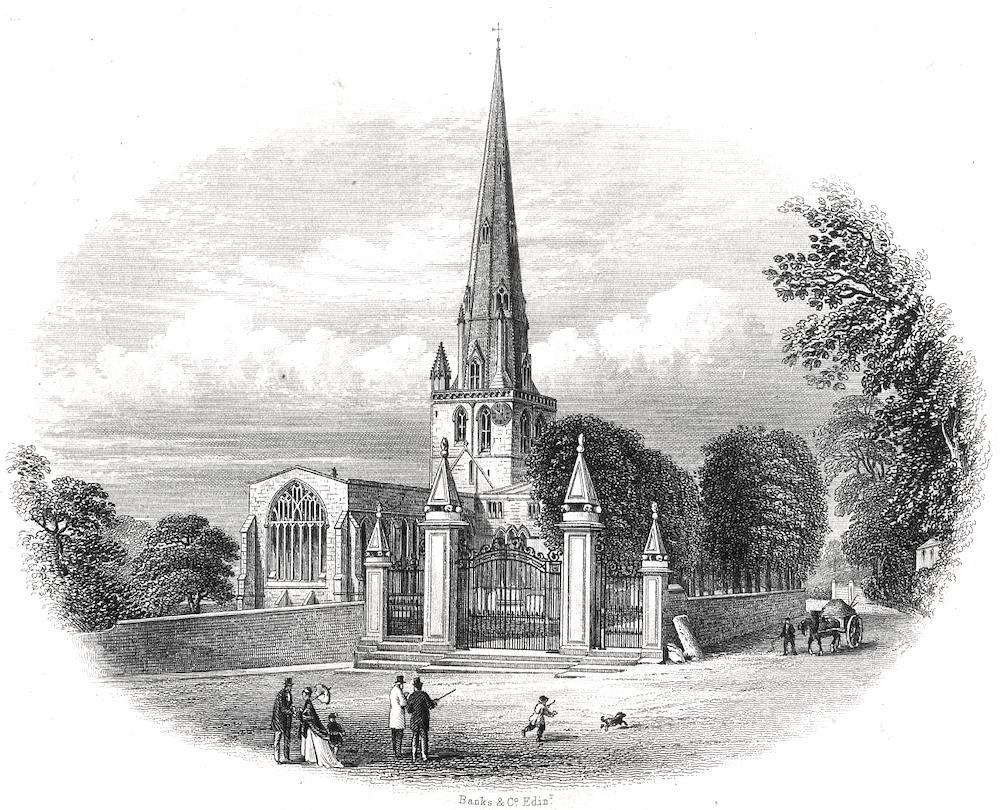Introduction

Etching and engraving of St Oswald's printed by Banks & Co., published by Edward Bamford, from the mid-nineteenth century. © The Trustees of the British Museum.
John Ruskin visited the Church of St Oswald in Ashbourne, Derbyshire, in 1875. He subsequently wrote to the vicar complaining about the window of David and Goliath, identified as being by William Warrington. Such was his standing that the letter was preserved and has been reprinted in the church's visitor's guide, so the following transcription is a copy of a copy from the guide of 1973. As with medieval copying, there may be a mistake, possibly a lost word, in his last sentence. Notice also that the copy spells the place-name Ashbourne in the heading of the letter, but Ruskin spells it without the "o" elsewhere: this may be a mistake by the copier, or simply a variation of spelling observable in other older sources. The letter is introduced in the following way: "The chancel has glass by Kempe with a few bits of medieval... The rest of the stained glass in the chancel is not outstanding: that above the priest’s door in the South wall showing David and Goliath so incensed Ruskin when he visited the church in 1875 that he wrote to the vicar as follows, expressing his opinion."
Letter to the Vicar

The slaying of Goliath vignette in the
window that so incensed Ruskin.
Ashbourne Jan. 27th, 1875
Sir, - I think it only my duty, though perhaps you may consider it an unwarrantable freedom on my part, to express to you the extreme regret and indignation with which I saw to-day the lancet windows of your chancel filled by out-and-out the worst piece of base Birmingham manufacture which, during a somewhat long experience, I have ever seen put in mockery of religious art; and heard further the report that it is intended to remove the few fragments of old heraldry, which have still some slight human interest in them, in the east window, in order to substitute the moral and physical foulness of these Birmingham shams. I should be very deeply sorry to include in what I shall have publicly to say respecting this church – your influence unjustly amongst those to which I must attribute this desecration, and should be only glad and grateful if you could justify me in holding you irresponsible. The mere loss of serviceable light (in a climate where the sun is not allowed to shine one day in seven) would be a weighty objection to the introduction of even the best painted glass in English churches; but when we have nothing better to put up than caricatures of bible history which would disgrace a penny child’s book of “Jack the Giant Killer,” the inconvenience becomes also an impiety. Your south transept window is better, but still a grievous mockery of faithful art; and how little your congregation care for colour is too woefully proved by the black path – as if meant to lead down to hell – with which they have flanked the lovely slope and road on the other side of the valley. If you would apply what funds you have at your disposal in giving honest labourers work to keep the path in pure golden gravel, and break up for road metal the skull obelisks* of your churchyard gate, all that could wisely do for the arts at Ashburne would be accomplished.
I am, Sir, your faithful servant
J. Ruskin
(D.C.L. Oxford)
*The skull obelisks that Ruskin wanted to break up for road metal were restored a few years later, in 1886. The decorations on the gate piers are described in the latest "Pevsner" as "flaming urns on top of obelisks, each resting on four skulls etc., c.1730" (Hartwell et al. 112). Their placement can be seen in the engraving of the church shown above.
Letter to Charles Eliot Norton about the same church
Interestingly, Steven Newman of the Minster Library in York has found another published letter written the same day, to Charles Eliot Norton, savaging the fifteenth-century "Cockayne Tombs" in the church for being "barbarous, ludicrous, and helpless in all the actual sculpture...." His visit to the church completely upset him, and he ends this part of the letter by saying "measuring my strength and circumstances, and possible time, it seems to me now expedient to trouble myself no more with history, mythology, or literature, but to concentrate myself on what I have peculiar gift for — natural history, including sky (not that we have much left of that in England), in connection with Turner's work only, and so end as I began" (110-11).
Bibliography
Hartwell, Clare, Nikolaus Pevsner and Elizabeth Williamson. The Buildings of England: Derbyshire. New Haven and London: Yale University Press, 2016, reprinted with corrections 2020.
Hollick, Kathleen M., and Armstrong, William Gerald. The Parish Church of St Oswald, Ashbourne: a short guide for visitors. Ashbourne: Avian Press, 1973: 9-10.
Ruskin, John. Letters of John Ruskin to Charles Eliot Norton. Vol. II. Boston: Houghton, Mifflin & Co, 1904. Internet Archive. Contributed by the Getty Research Institute. Web. 26 September 2021.
Created 27 September 2021